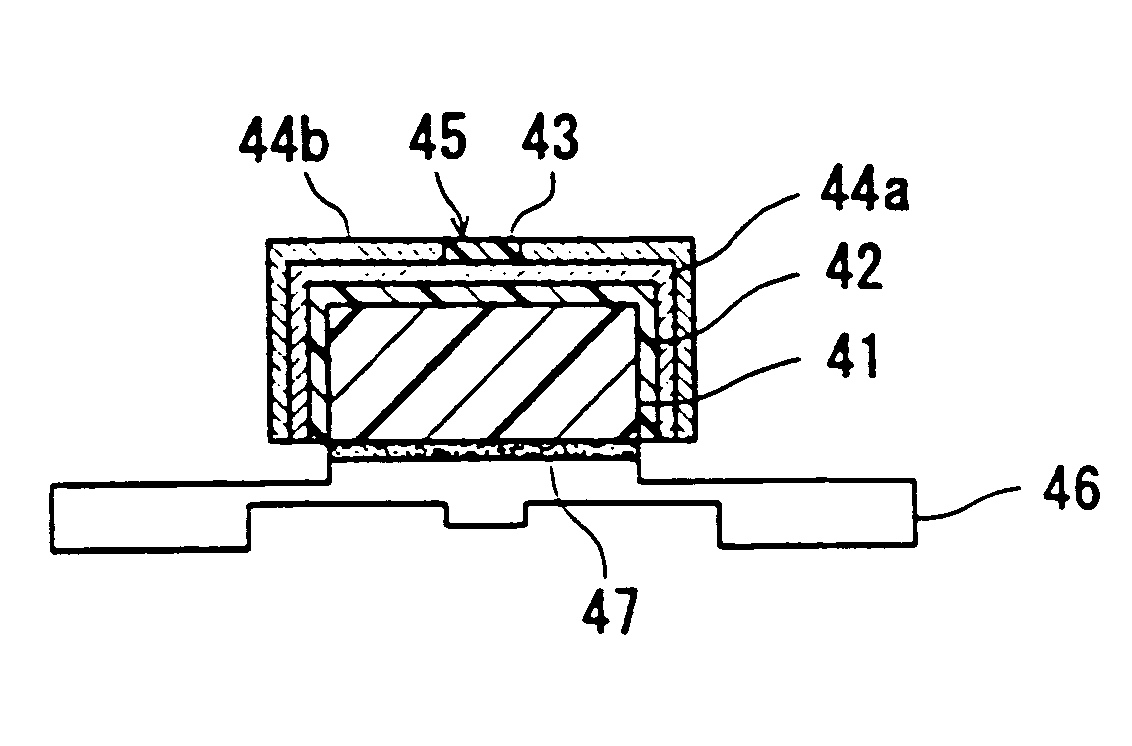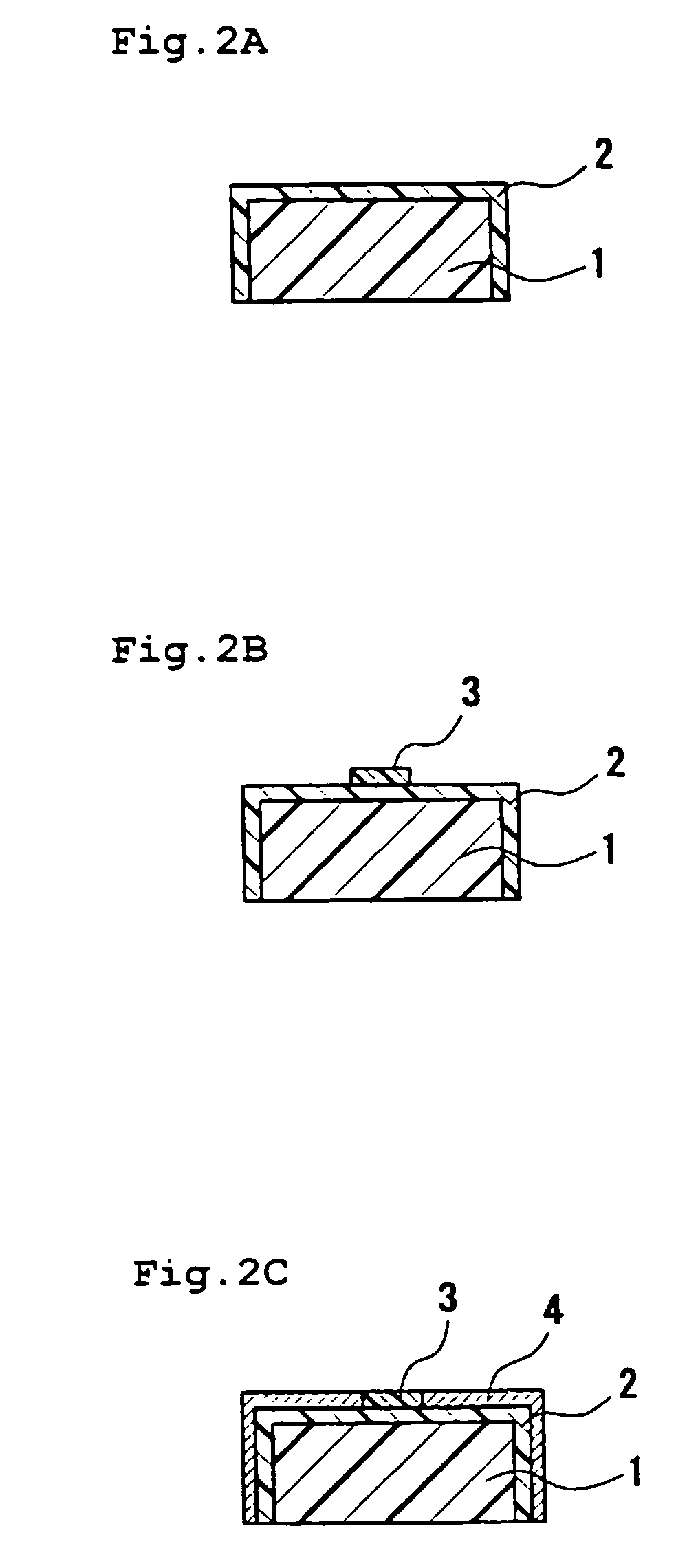Method of producing the keytop for pushbutton switch
a technology of keytops and pushbutton switches, applied in the field of keytops, can solve the problems of dust likely to adhere during coating, thin metal layer formed by vapor deposition or sputtering, and wear, and achieve the effects of low cost, good yield and rich design
- Summary
- Abstract
- Description
- Claims
- Application Information
AI Technical Summary
Benefits of technology
Problems solved by technology
Method used
Image
Examples
example 1 fig.3
Example 1 FIG. 3B
[0116]ABS resin (3001 MF, trade mark, produced by Mitsubishi Rayon Co., Ltd.) of a plating grade was dissolved in an organic solvent, cyclohexanone (Wako Pure Chemical Industries, Ltd.), whereby ABS resin ink containing 1000 parts by weight of cyclohexanone based on 100 parts by weight of the ABS resin was prepared for forming a base layer.
[0117]The above-mentioned ABS resin ink was pad-printed at a desired position on the surface of a key top body 11 made of a polycarbonate (PC) resin molded by injection molding. Thereafter, the organic solvent, cyclohexanone, was completely removed by a dryer at 80° C., whereby a base layer 12 was formed. The base layers 12 with the following thicknesses were formed: 3 μm to 5 μm, 8 μm to 10 μm, 13 μm to 15 μm, and 20 μm to 22 μm.
[0118]Next, the surface of the base layer 12 was defatted. Thereafter, the base layer 12 was soaked in an etchant containing chromic acid (400 g / l) and sulfuric acid (200 ml / l) at 70° C. for 2.5 minutes, ...
example 2 fig
[0121]Base layer ink was prepared in the same way as in Example 1, using ABS resin (3001 MF, trade mark, produced by Mitsubishi Rayon Co., Ltd.) of a plating grade. The base layer ink was screen-printed onto the surface of a polyethylene-based resin film 28 to form an insulating base layer 22. The thickness of the base layer 22 was 5 μm. Then, an acrylic-based ink was applied, as a polymer coating ink, to a desired position on the surface of the base layer 22 by pad printing to form a polymer coating layer 23. An adhesive layer 29 was formed on the reverse surface of the resin film 28, using a white urethane-based ink. The resin film 28 was curved with a die, and the curved convex portion was filled with PC resin, whereby a key top body 21 integrated with the resin film 28 was obtained. After an etching treatment, a nickel electroless plating layer 24 was formed by electroless plating on the surface of the base layer 22. The key top was attached to a keypad 26 via an adhesive layer ...
example 3 fig.8
Example 3 FIG. 8
[0123]First, 100 parts by weight of ABS resin (3001 MF, trade mark, produced by Mitsubishi Rayon Co., Ltd.) of a plating grade was dissolved in 1000 parts by weight of cyclohexanone, and 2 parts by weight of a fluorine type leveling agent (Schwego Flour 8038, produced by Brend Schwegmann) was further mixed in the solution to prepare an ABS resin coating.
[0124]The ABS resin coating was applied by spray coating to the surface of a key top body 41 made of PC resin (polycarbonate resin) molded by injection molding. Thereafter, the ABS resin coating was dried by a box drier at 100° C. for 60 minutes to completely remove cyclohexanone, thereby forming a base layer 42 made of ABS resin with a thickness of 8 μm to 10 μm.
[0125]The surface of the key top on which the base layer 42 was formed was subjected to an etching treatment, and was coated with a catalyst. Thereafter, a nickel electroless plating layer 44a with a thickness of 30 nm was formed. On the surface of the electr...
PUM
| Property | Measurement | Unit |
|---|---|---|
| transmittance | aaaaa | aaaaa |
| transmittance | aaaaa | aaaaa |
| transmittance of visible | aaaaa | aaaaa |
Abstract
Description
Claims
Application Information
 Login to View More
Login to View More - R&D
- Intellectual Property
- Life Sciences
- Materials
- Tech Scout
- Unparalleled Data Quality
- Higher Quality Content
- 60% Fewer Hallucinations
Browse by: Latest US Patents, China's latest patents, Technical Efficacy Thesaurus, Application Domain, Technology Topic, Popular Technical Reports.
© 2025 PatSnap. All rights reserved.Legal|Privacy policy|Modern Slavery Act Transparency Statement|Sitemap|About US| Contact US: help@patsnap.com



